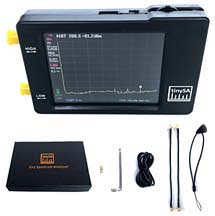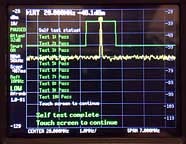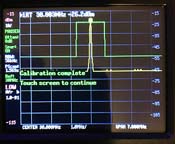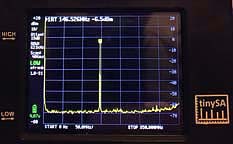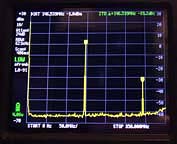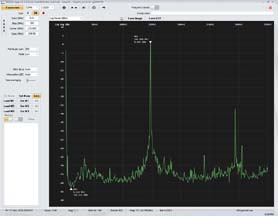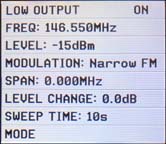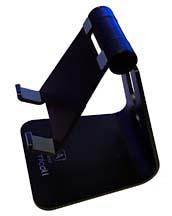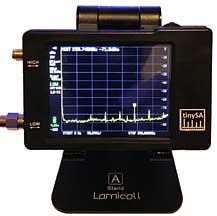Product Review
TinySA
Tiny Spectrum Analyzer
100kHz to 350MHz
240MHz to 960MHz
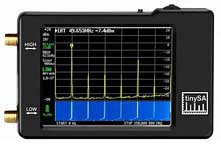
John 'Miklor' K3NXU
November 2020
|
What does a Spectrum Analyzer do?
The most common use is to determine whether a transmitter is operating within its specified parameters for purity of emissions by showing harmonics, spurs, bandwidth, etc. The output side of the TinySA can also be used as a signal generator. What's in the Box - The TinySA Spectrum Analyzer - SMA-M Antenna - SMA-F to F adapter - 39.5" (1m) USB to USB-C charge / program cable - (2) 8" (21.5cm) SMA-M to M Jumpers - Pointer
Description / Specifications - Low Input Range is from 100kHz to 350MHz - High Input Range is from 240MHz to 960MHz - Display - 2.8" TFT (320x240) Touch Screen - USB serial port control - Linear power supply to avoid switching noise Detailed specifications can be found here. (LINK). User Guide and Operating Manual Along with an extensive online wiki, there is a series of videos to guide you through its setup and capabilities. If features are added, they'll be shown online. Here's a link to the YouTube videos. Setup, Calibration and Testing After watching the Introduction Video, the initial setup took less than 5 minutes. The calibration and testing functions are preprogrammed and just a matter of selecting the setup options. - Config / Self Test - This takes about 12 seconds an takes the unit through a 10 step systems test. - Config / Level Cal / Calibrate - Takes about 2 seconds and you are ready the go.
For the basic tests that I performed, the included antenna worked perfectly. The instructions caution against connecting the transmitter directly to the analyzer unless you have an assortment of attenuators. Harmonic suppression seems to be a hot topic among handheld users so I put a few of mine through the spectrum test. I found the results interesting. - The first image shows a BTech DMR-6X2 and Anytone D878. Both models displayed the exact same graph. - The second graph (a different model) showed a distinct 2nd harmonic only 32db down from the fundamental frequency. I'm not disclosing the model of the second radio as two identical units can have different characteristics. However, it was not a Baofeng.
I found the 2.8" screen resolution was clear and added to the portability, but if you have a PC or Laptop at your workbench, the TinySA can now easily be software controlled. Here is a screen image of the above test. The software is on their website (LINK).
Another piece of equipment I was able to eliminate from my bench was my old signal generator. I tested the SG capability and it worked perfectly. Enter the frequency and a few basic parameters and you are ready to go.
The firmware in the TinySA can be updated by the user to add additional functionality in the future, but the stock FW seems to be working fine. If you do desire to update the unit, prior and future FW releases can be found on their website. (LINK). You can always have the latest or retro fit to a prior version. Online User Guide There's an excellent detailed online guide for the TinySA calibration, operation and measurements that can be found at TinySA.com. This is a Must Read for new users. Add-Ons The TinySA comes with everything you need to get started, but I did add couple useful items. - Although it comes with a small pointing devise, I use one of my tablet stylus. - Also, I picked up a couple cell phone stands which also comes in handy on the bench. I keep my TinySA on one and my NanoVNA on the other.
Conclusion Don't let the name fool you. I've only had mine for about a week and for basic work bench functions, the TinySA is great. It's not the Agilent, IFR or Tektronix that I have used in the past, but it's also not $2-10K plus and weighs a lot less than 10+ pounds. There's plenty of power inside this small package and it's functions are all well documented in both online and video formats. Note: This equipment was purchased me. This is an unbiased review. All findings are factual based my personal experience.
|
TOP of PAGE
Miklor Home
Miklor Home
BTECH 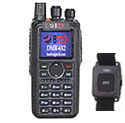 DMR6X2 PRO Dual Band (Review) Anytone 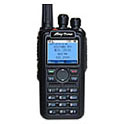 D878UV II+ Dual Band (Review)  D578UV Series Mobiles Hotspot  SkyBridge MAX (Review) Ailunce 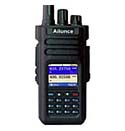 HD1 / GPS (Review) Amplifiers  BTECH DMR Amps UHF VHF (Review) Repeaters  Ham / GMRS Commercial Repeaters Duplexers |
